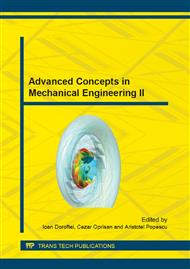p.421
p.425
p.431
p.435
p.440
p.446
p.450
p.456
p.463
Experimental Investigation of Waste Heat Available for a Hybrid Micro-Cogeneration Group Involving a Diesel Engine Electric Generator and Organic Rankine Cycle
Abstract:
The paper presents the work developed in the first stage of Research Grant called "Hybrid micro-cogeneration group of high efficiency equipped with an electronically assisted ORC" (acronym GRUCOHYB). The Research Grant is in progress at the Thermal Research Centre, Faculty of Mechanical and Mechatronics Engineering from University Politehnica of Bucharest having as research partner the Rokura Company. The hybrid micro-cogeneration group involves the use of an electric generator based on a 40 kW overcharged Diesel engine and an Organic Rankine Cycle (ORC). The aim of the research is to recover the waste heat available in the exhaust gas and cooling water and transfer it to the ORC in order to convert it into electricity. A description of the experimental setup is given according to the current stage of development. Also the paper presents the experimental results obtained and which show the amount of waste heat available for recovery for different engine operation loads. Based on these experimental results the proper ORC configuration and working fluid can be determined. Several possible ORC configurations suitable for this application are highlighted. Future work and development perspectives are also discussed.
Info:
Periodical:
Pages:
440-445
Citation:
Online since:
October 2014
Price:
Сopyright:
© 2014 Trans Tech Publications Ltd. All Rights Reserved
Share:
Citation:


